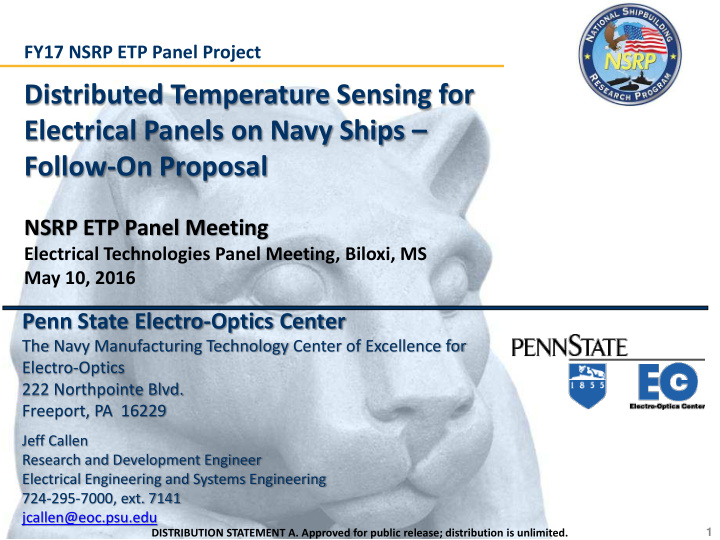



FY17 NSRP ETP Panel Project Distributed Temperature Sensing for Electrical Panels on Navy Ships – Follow-On Proposal NSRP ETP Panel Meeting Electrical Technologies Panel Meeting, Biloxi, MS May 10, 2016 Penn State Electro-Optics Center The Navy Manufacturing Technology Center of Excellence for Electro-Optics 222 Northpointe Blvd. Freeport, PA 16229 Jeff Callen Research and Development Engineer Electrical Engineering and Systems Engineering 724-295-7000, ext. 7141 jcallen@eoc.psu.edu DISTRIBUTION STATEMENT A. Approved for public release; distribution is unlimited. 1
Inspection of Medium Voltage Electrical Panels on Navy Ships – the issues • Connections in electrical panels on Navy Ships are presently inspected using infrared thermography through open panel while under load. A bad connection shows up as much hotter than connections on adjacent phases. • Medium to high voltage panels require OSHA waivers or preclude open panel inspection at all. • Recently concluded NSRP panel project investigated use of IR transparent windows in panel covers to permit thermography without opening the panel. • Results showed that use of IR windows was a viable method for continuing the infrared thermography inspections. Mil standards are being revised to include IR windows in these cabinets, and the information learned from the project is providing guidelines for the revisions. However, some limitations were uncovered during the project: – Components and devices within the cabinets can be obstructions to viewing the connections from the windows. Providing line of sight is a significant design challenge for the panel manufacturers - 100 % coverage of all connections might not be possible. – Medium and high voltage cabinets require an insulating dust boot covering all connections, to reduce the chance of arcing from electrical creep or tracking. The boot materials tested are not transparent to IR wavelengths and the temperature of the connection can only be inferred from hotspots on the outside of the boot or the cable exiting the boot. Visible image through window. Red dust boot covering connections Thermal image of dust boot and cables with simulated fault 2
Inspection of Medium Voltage Electrical Panels on Navy Ships – Long Term Solution Proposal • Investigate viability of Distributed Temperature Sensing (DTS) over fiber optic for monitoring temperature of switchgear connections. Benefits include: – 100% coverage of all connections, beneath dust boots and independent of windows – Permanently installed, continuous, programmable temperature monitoring. – Alert to problems as they develop, not when approaching failure. Monitor trends for predictive maintenance. • Trade Study of different methods – technical feasibility, implementation/maintenance requirements, cost – Raman Shift – wavelength shift of light from thermally excited molecules in the fiber, producing longer (Stokes) and shorter (Anti-Stokes) wavelength components. Anti-Stokes is temperature sensitive. – Fiber Bragg Gratings – In-fiber gratings reflect particular wavelengths and shift due to temperature rise. Shift proportional to temperature. Particular wavelength indicates location. – Rayleigh Scattering – scattering of light off impurities in fiber as if they were gratings. Broadband excitation. Reflections converted to time domain to determine location down the fiber. • Refine options with bench top demonstration – determine feasibility and practicality • Test one or two methods in a relevant electrical cabinet (actual or simulated) – Temperature accuracy in normal and fault conditions, spatial accuracy (location of fault) – Determine issues relevant to installation and maintenance • Provide recommendations for future implementation and assessment of cost benefits. Fiber Bragg Gratings Raman Shift 3
Recommend
More recommend